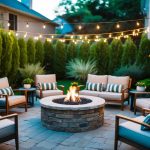Building a Backyard Shed: Essential Tools and Plans for DIY Enthusiasts
Interior Setup
Creating an efficient interior for your shed involves strategic organization and optimizing workspaces. Proper planning helps ensure the shed meets your needs, be it for storage, hobbies, or both.
Organizing the Internal Space
Maximizing the shed’s functionality starts with determining what needs to be stored. Heavier items like lawnmowers or bulky tools should be placed near the entrance for easy access. Utilizing vertical space is crucial, so wall pegboards can keep frequently used tools off the ground and within reach. Categories and labels help maintain order—assign specific spots for gardening tools, electrical equipment, and seasonal items. Clear bins or containers offer visibility, while hooks on the walls or doors can hold items like hoses and cords neatly in place. Well-thought-out plans can turn a cluttered area into a harmonious storage solution.
Installing Shelving and Workbenches
Durability and accessibility are key when setting up shelving and workbenches. Shelving should be robust enough to handle heavy items, with adjustable options allowing flexibility for different storage needs. Installing shelves above eye level saves ground space. Workbenches provide a dedicated space for projects, so choosing a sturdy surface that suits planned activities is important. Wall-mounted workbenches can be beneficial in tight spaces. Consider incorporating storage beneath the bench for tools and materials needed on a regular basis. Thoughtful layout and quality materials ensure the interior remains functional and accommodating for various tasks.
Maintenance and Upkeep
Regular maintenance of a backyard shed ensures its longevity and functionality. To start, inspecting the structure for any signs of wear or damage is crucial. This includes checking for issues like leaks, rust, or loose screws, particularly if they used a shed kit which may include metallic components.
Keeping the shed clean and dry is another essential task. Moisture can lead to mold and rot, especially in wooden sheds. It’s wise to clear debris from the roof and gutters to prevent water accumulation. Moreover, the organization within the shed can enhance its usability. They should ensure that tools and materials are stored appropriately, allowing for easy access and reducing clutter.
For those who built their shed using a do-it-yourself approach, it’s important to occasionally tighten bolts and secure joints. Seasonal checks for pest infestations, such as termites, are recommended to ensure wood stability. Additionally, applying weatherproofing treatment or a fresh coat of paint can protect the shed from the elements. Regular upkeep not only preserves the shed’s condition but also maximizes its utility for storage or workspace needs.
Customization and Add-Ons
Enhancing your backyard shed can make it more functional and visually appealing. Consider integrating practical features like lighting or transforming the surrounding landscape to complement your shed’s style.
Adding Lighting and Electrical
Installing lighting and electrical outlets in a backyard shed can significantly extend its usability. A lean-to shed could benefit from these additions, transforming it into a functional workspace. Fit suitable weatherproof lighting fixtures to ensure safety and durability.
Running electrical wires requires careful planning and adherence to local building codes. Consider hiring a certified electrician for complex setups. Deciding on LED lights offers energy efficiency and long-lasting performance. Strategically placed outlets can power tools or small appliances, enhancing convenience and usability for any DIY project or garden shed.
Landscaping and Surrounding Area
Landscaping the area surrounding a shed enhances both its appeal and accessibility. Start by designing a pathway using pavers, gravel, or wood chips from the main house. This not only improves access but also keeps dirt and moisture away from the structure’s foundation.
Incorporate plants and shrubs around the shed to blend it aesthetically into the garden environment. Choose plants that complement the existing garden design. Additionally, adding a small outdoor seating area can create a relaxing retreat for enjoying the outdoors. Ensuring proper drainage is crucial when landscaping, as water accumulation can damage the shed’s foundation over time.



